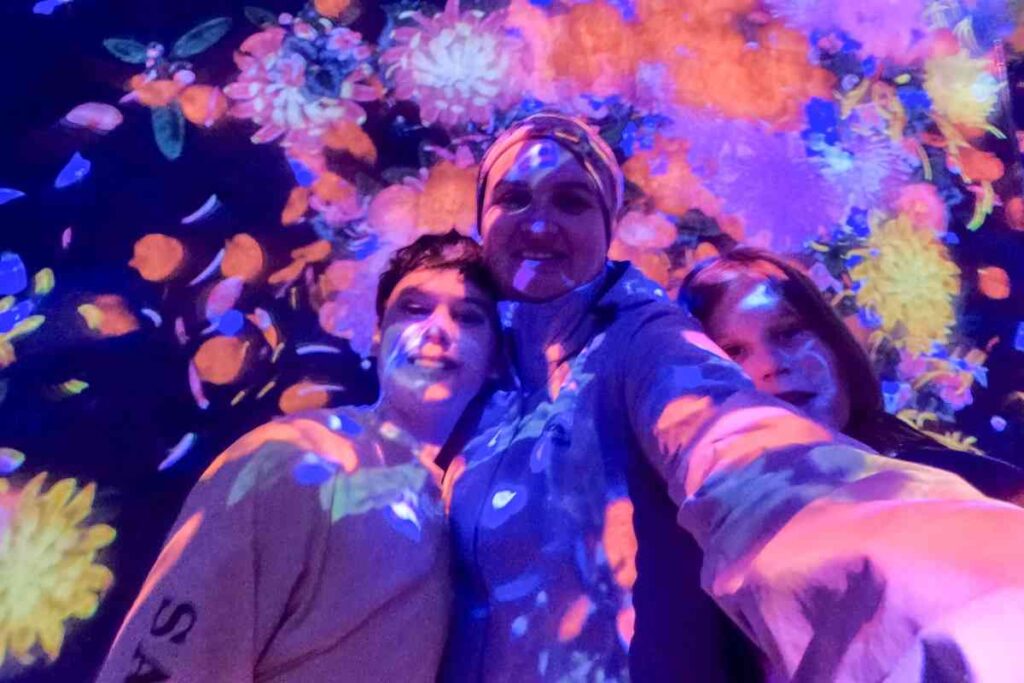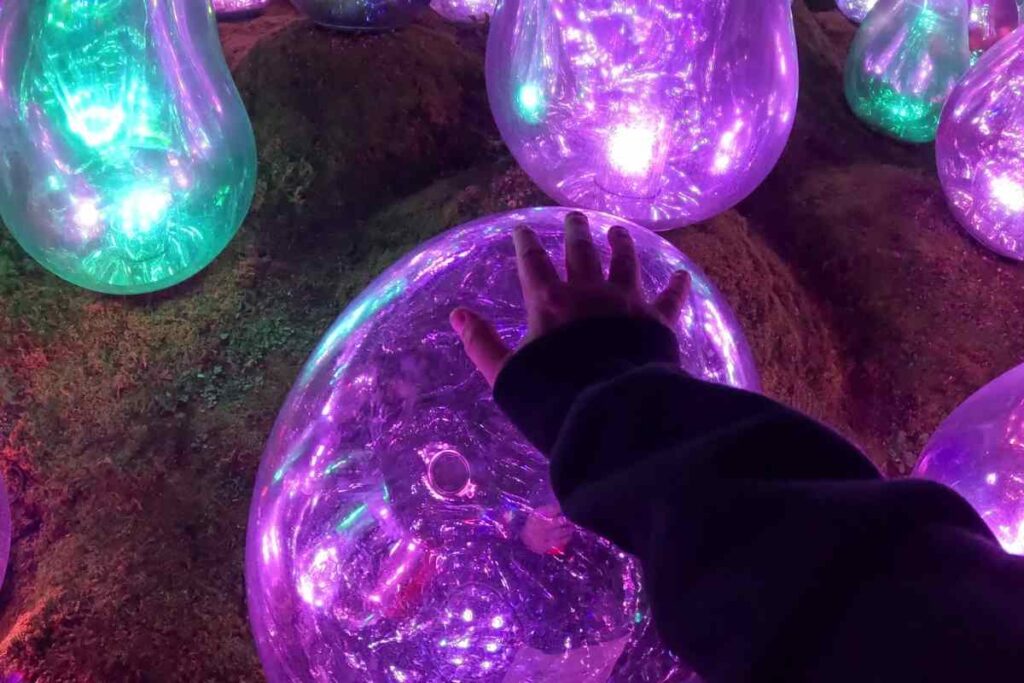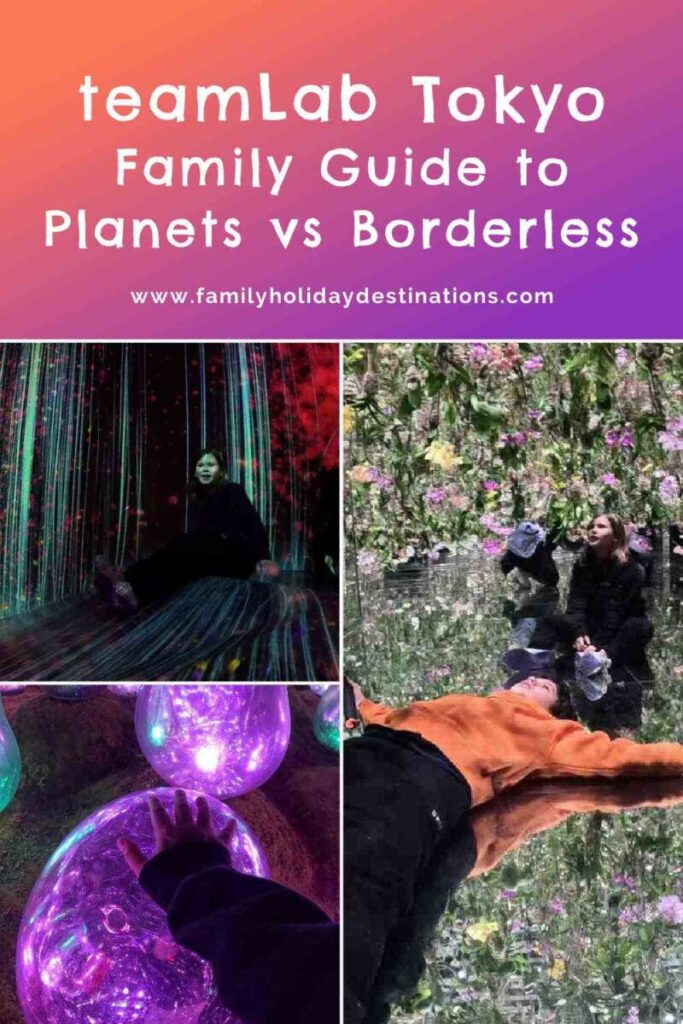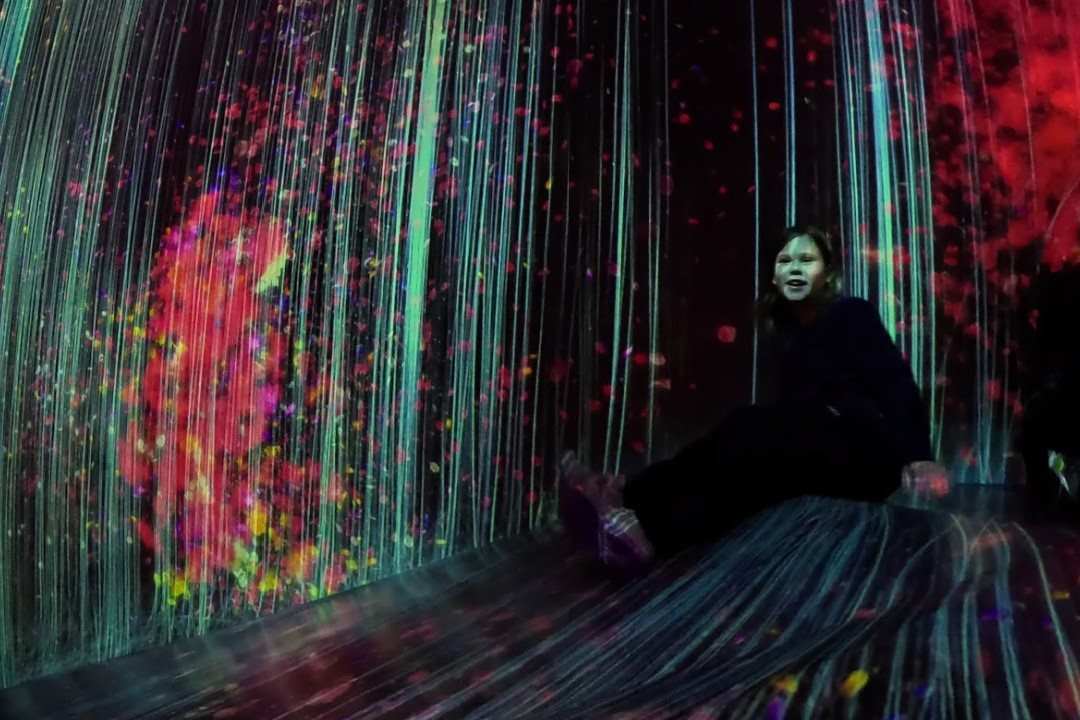Wading barefoot through knee-deep water while digital koi swam beneath our legs, only to explode into what appeared to be flower petals when we reached out to touch them, was not how I pictured our first day in Japan going, but that’s the wonder of visiting teamLab Tokyo with kids for you.
teamLab is a renowned immersive digital art installation based in Tokyo, Japan. It works with advanced technology to create incredible interactive experiences on a large scale, challenging traditional forms of artistic expression. The installations frequently change in response to the viewer’s movements, creating a fun environment in which you’ll never find a dull moment.
We visited both teamLab Planets and teamLab Borderless in Tokyo with the goal of exploring which one was better for families.

Quick overview: What are teamLab Planets and Borderless
As mentioned above, both teamLab venues in Tokyo are immersive digital art installations that span many rooms. You don’t need to be ‘into art’ to enjoy them, and you can explore them at your own pace. If you have the time to visit both, you absolutely should, as they are both very different experiences.
teamLab Borderless seems to revolve around the idea of a fluid, seamless space where the boundaries between artworks are ‘borderless’. If you go back into the same room twice, you are likely to find artwork that has since floated or walked in from another room and is now interacting in a different way and with other pieces. It feels maze-like and has a larger, more open layout. A highlight for kids at teamLab Borderless in Tokyo is the Sketch Aquarium. Visitors can draw and colour a fish, which is then scanned and brought to life in an interactive aquarium room that responds to your touch, even showing up in other teamLab exhibitions around the world.
teamLab Planets in Tokyo is more interactive in that it encourages kids and parents to engage with the art through movement and their physical presence. Planets is smaller and features designated rooms that highlight specific sensory experiences, such as a room with knee-deep water in which digital koi fish swim around your legs. It feels a bit more intimate, and you can engage more closely with the art.
In summary, while both teamLab Tokyo’s offer immersive digital art experiences, they offer different themes, designs and interactions, each providing a unique platform for kids and parents to experience contemporary art.
Our experience of visiting teamLab Tokyo with kids
The adults enjoyed teamLab Planets more than teamLab Borderless because it was more interactive. Starting with the water room, we removed our shoes and were ushered along an inclined corridor in ankle-deep chlorine-smelling water. At the end of the corridor, we were handed a towel to dry our feet (the corridor must have been to wash them) and shown where to dump the now dirty towel. After that, we were free to explore the water room with the digital koi fish, which we all really enjoyed. Once you leave the water exhibit, you return to a locker to put your shoes back on and wander through the remaining exhibits.
The kids enjoyed teamLab Borderless more, which really surprised us as it’s not as interactive. There is one particular room that is quite large, with a raised section in the middle that you can slide down, and I think this sealed the deal for them. Although our youngest (aged nine at the time) said she liked Borderless more, she struggled with some of the rooms here due to the flashing and sometimes overwhelming lights. If you have a child who is a little sensitive to such things, you’ll need to come prepared with your usual coping strategies.

TeamLab Planets vs Borderless: What’s the difference for families?
| Feature | teamLab Planets | teamLab Borderless |
|---|---|---|
| Location | Toyosu | Azabudai Hills |
| Duration | 2-3 hours | around 3 hours |
| Interactivity | High (physical movement, water) | Medium-High (exploration, discovery) |
| Toddler-friendly? | Less so due to water, darkness | More so |
| Stroller access | No | Limited |
| Photography | Allowed (no flash) | Allowed (no flash) |
| Who liked it better? | Parents | Kids |
What to know before you go to teamLab Tokyo with kids
Tickets
You’ll need to book tickets well in advance; don’t leave it until you arrive in Tokyo. To avoid the crowds, book during the first and last two hours on weekdays.
👉 Get your teamLab Planets tickets here.
👉 Get your teamLab Borderless tickets here.
What to wear
TeamLab Borderless simply requires comfortable clothes that you can walk around in. However, for teamLab Planets, you’ll need to wear shorts or pants you can roll up above your knees and easily removable shoes. Don’t wear skirts or dresses unless you are wearing shorts underneath, as a few of the exhibits have mirrored floors.
Age suitability
TeamLab planets will be harder to manage for toddlers, as you’ll need to carry them through the water section. If you’re happy to do this, go for it!
Food
There are no restaurants within the exhibition, and once you’ve left, you can’t go back in. So, make sure everyone is well fed before you arrive.
What to bring
Bring a small towel and a change of clothes in case your kids get their shorts wet. A camera is allowed, but your flash, selfie-stick, GoPro handle and tripod/monopod are not.
There’s an app for that
Download the teamLab app before you go, as some of the exhibits are extra interactive:

Final verdict: Which one should you choose?
If your kids are well past the toddler stage, then I would choose teamLab Planets due to the fun water experience. I would also choose Planets if anyone has sensory issues, as I personally found Borderless just that little bit more overwhelming due to the lights, size and crowds.
If you have younger kids, I would choose Borderless so you don’t have to deal with the whole water section with a squirmy toddler.
However, if you have time, I totally recommend doing both as they are both a lot of fun!
Getting to teamLab Tokyo with kids & practical info
Locations with Google Map links
- teamLab Planets – Google Map Link here
- teamLab Borderless – Google Map Link here
Nearest train stations
- teamLab Planets – 1 minute on foot from the North exit of Shin-Toyosu Station (Tokyo Waterfront New Transit Waterfront Line Yurikamome Line) and 5 minutes on foot from Shijoumae Station and Toyosu Market (Tokyo Waterfront New Transit Waterfront Line Yurikamome Line).
- teamLab Borderless – 2 minutes walk from Exit 5 of Kamiyacho Station on the Tokyo Metro Hibiya Line. Kamiyacho Station on the Hibiya Line is a subway station. After exiting Exit 5, do not go up to the ground level, but continue through the underground passage. Alternatively, it’s a 7-minute walk from Exit 4 of Roppongi-Itchome Station on the Tokyo Metro Namboku Line.
Ticket links
- 👉 Get your teamLab Planets tickets here.
- 👉 Get your teamLab Borderless tickets here.
Opening hours
- teamLab Planets – 9:00 am to 10:00 pm daily. The last entry is one hour before closing. You may have to wait 3 – 60 minutes to be admitted to the venue. Check the website for planned closures.
- teamLab Borderless – 9:00 am – 11:00 pm daily. The last entry is one hour before closing time. Check the website for planned closures.
Website links
Videos and reels
FAQs: teamLab Tokyo with kids
Allow around 2 to 3 hours for teamLab Planets and 3 hours for teamLab Borderless.
This boils down to personal preference, but those with toddlers will probably find teamLab Borderless easier as it doesn’t have a water component and is more accessible with flat, hard floors. For kids a little older, teamLab Planets is amazing as it’s more of an interactive experience with different floor types, including a water floor.
For teamLab Planets, wear shorts or pants you can roll above your knees and shoes that are easily removable due to the water room. Avoid wearing skirts or dresses as some of the floors are mirrored. TeamLab Borderless simply requires comfortable clothes that you can walk around in.
Yes. Both experiences regularly sell out. Make sure to book before you arrive in Tokyo to avoid disappointment.
Yes, but with some caveats. teamLab planets involves walking barefoot through water and navigating dark, mirrored spaces, which could be difficult with a toddler. It’s better suited to kids aged 6 years and up. Mine were 9 and 12 years, and we had no problems.
Strollers are not allowed inside either experience, so you’ll need to park them in the designated stroller parking area outside and use a baby carrier.
Yes, both venues have toilet facilities and baby changing areas.
Yes, but you are not allowed to use your flash. You are also not allowed to use a selfie stick, a tripod or a monopod. I was not allowed to take my GoPro handle in.
This article contains affiliate links to products. We may receive a commission for purchases made through these links.
Where to next?


Let me know what you think!